 Today fly fishing on Farquhar in the Seychelles truly began. I fished with my cabin mate Rich Cambria and today’s guide was Matthieu Cosson from France. Matthieu is an experienced FlyCastaway guide who’s fished nearly all the waters of the Seychelles. Matthieu gave us an in depth rundown of our fishing plans for the day and let’s just say we had a lot of fun things on the agenda.
Today fly fishing on Farquhar in the Seychelles truly began. I fished with my cabin mate Rich Cambria and today’s guide was Matthieu Cosson from France. Matthieu is an experienced FlyCastaway guide who’s fished nearly all the waters of the Seychelles. Matthieu gave us an in depth rundown of our fishing plans for the day and let’s just say we had a lot of fun things on the agenda.
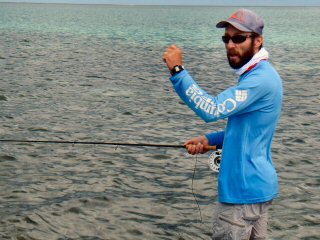 Fishing plans will be based hugely on tides this week. We have a full moon coming and tides will fluctuate to the max and the fish will undoubtedly be affected. Our first move was to search for bump head parrot fish (bumpies) on a nearby flat (I guess it’s already leaked out that my personal goal this trip is to catch a bumpy head). Potential bad news however, last week there were almost none to be found.
Fishing plans will be based hugely on tides this week. We have a full moon coming and tides will fluctuate to the max and the fish will undoubtedly be affected. Our first move was to search for bump head parrot fish (bumpies) on a nearby flat (I guess it’s already leaked out that my personal goal this trip is to catch a bumpy head). Potential bad news however, last week there were almost none to be found.
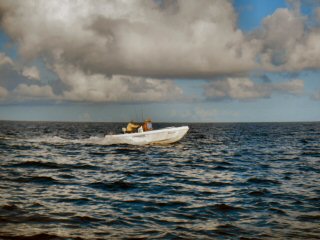 The weather here by the equator is always hot. This morning winds were light, there were lots of clouds and we had a few sprinkles. When it’s cloudy on the flats it can be hard to spot fish unless they’re tailing, waking of causing nervous water. As we crossed the inside of the atoll close to camp Matthieu’s plan would be interrupted by milkfish.
The weather here by the equator is always hot. This morning winds were light, there were lots of clouds and we had a few sprinkles. When it’s cloudy on the flats it can be hard to spot fish unless they’re tailing, waking of causing nervous water. As we crossed the inside of the atoll close to camp Matthieu’s plan would be interrupted by milkfish.
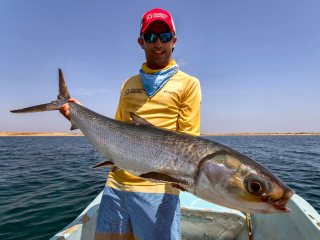 At least an acre of finicky grass-carp-like milkfish were feeding on the surface. I don’t have milkfish on this week’s wish list but I’d certainly take one. The Seychelles is a top location to target the nearly impossible plankton eating species. You may remember friend Mark Murray and I had a successful milkfish session in Sudan last March. A session that ended with an epic battle and a 25lb milkfish for Mark. I told Rich to take the bow and try to catch one.
At least an acre of finicky grass-carp-like milkfish were feeding on the surface. I don’t have milkfish on this week’s wish list but I’d certainly take one. The Seychelles is a top location to target the nearly impossible plankton eating species. You may remember friend Mark Murray and I had a successful milkfish session in Sudan last March. A session that ended with an epic battle and a 25lb milkfish for Mark. I told Rich to take the bow and try to catch one.
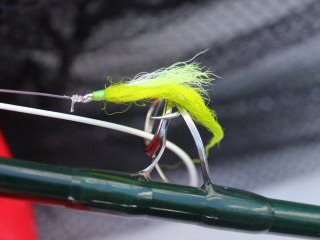 Matthieu chopped Rich’s crab from his 9-weight and replaced it with a Milky Dream. This milkfish fly looks like a size 2 piece of weed. The idea is to drop the concoction directly in front of a school of milkfish and hope one finds it. They rarely move for the fly so it literally needs to hit them in the face. You cast right in front of as many milkfish as you can and stay tight with a very slow long strip, moving the fly through the zone before it sinks below them. Some milkfish skim the surface with their faces above water while the real eaters are just below.
Matthieu chopped Rich’s crab from his 9-weight and replaced it with a Milky Dream. This milkfish fly looks like a size 2 piece of weed. The idea is to drop the concoction directly in front of a school of milkfish and hope one finds it. They rarely move for the fly so it literally needs to hit them in the face. You cast right in front of as many milkfish as you can and stay tight with a very slow long strip, moving the fly through the zone before it sinks below them. Some milkfish skim the surface with their faces above water while the real eaters are just below.
Rich made numerous casts but the milkfish disappeared. Again, these fish aren’t easy. They disappeared but luckily in the distance bumpy head tails were waving.
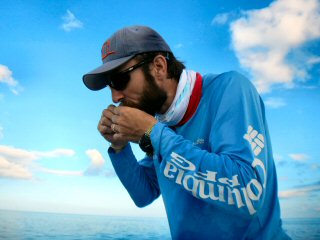 Matthieu anchored us on the edge of the flat and retied a crab on Richs 9-weight. I held back again and watched as Matthieu eased Rich into range on foot. All bumpy heads are big. These ones looked on the small end of big likely in that 25 – 35lb range.
Matthieu anchored us on the edge of the flat and retied a crab on Richs 9-weight. I held back again and watched as Matthieu eased Rich into range on foot. All bumpy heads are big. These ones looked on the small end of big likely in that 25 – 35lb range.
I’m no expert on bumpies but they’re parrotfish and do more picking at coral than anything. That being said they’ll crack a crab and crab patterns are the best option. The idea is to sink it in front of them, stay tight and hope one picks it up. It’s basically the same technique for permit only we soon learned that bumpies may be spookier.
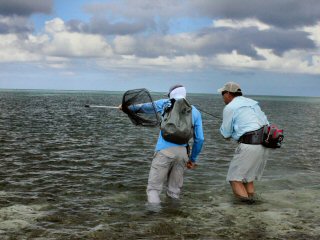 Rich got numerous casts at the bumpies but to no avail. Eventually they caught on and moved off the flat not to be seen again. Matthieu then took us a short boat ride to the next place.
Rich got numerous casts at the bumpies but to no avail. Eventually they caught on and moved off the flat not to be seen again. Matthieu then took us a short boat ride to the next place.
The next spot was an ocean flat and sure enough, there were more tailing bumpies. Rich and Matthieu took off in pursuit. This time I grabbed my rods and headed out as well.
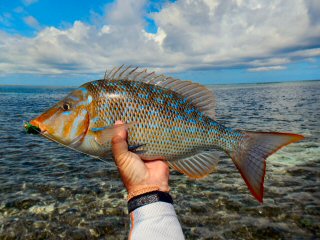 Tag teaming a school of fish on the flats is a sure way to spook them all. I headed in the opposite direction in hopes to find some bumpies of my own. The tails of the bumpies are so huge that I could see in my direction there were none. However, some interesting smaller tails skimmed the surface in the turtle grass ahead. I eased my way there and dropped a crab to the mysterious fish. Four blue spangled emperor fish charged my crab and for the next half hour I hammered away on this colorful new species for my life list.
Tag teaming a school of fish on the flats is a sure way to spook them all. I headed in the opposite direction in hopes to find some bumpies of my own. The tails of the bumpies are so huge that I could see in my direction there were none. However, some interesting smaller tails skimmed the surface in the turtle grass ahead. I eased my way there and dropped a crab to the mysterious fish. Four blue spangled emperor fish charged my crab and for the next half hour I hammered away on this colorful new species for my life list.
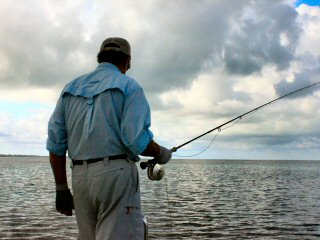 Meanwhile Rich and Matthieu worked the bumpy school, gradually pushing them to deeper water and soon out of reach. I kept a watchful eye as to pick up any of the dos and don’ts to perhaps help me in my own pursuit this week. I joined up with them just in time to spot a huge shadow a football length ahead. My fish spotting eyes were coming together and soon Matthieu could also see the suspicious shape. It was a giant trevally.
Meanwhile Rich and Matthieu worked the bumpy school, gradually pushing them to deeper water and soon out of reach. I kept a watchful eye as to pick up any of the dos and don’ts to perhaps help me in my own pursuit this week. I joined up with them just in time to spot a huge shadow a football length ahead. My fish spotting eyes were coming together and soon Matthieu could also see the suspicious shape. It was a giant trevally.
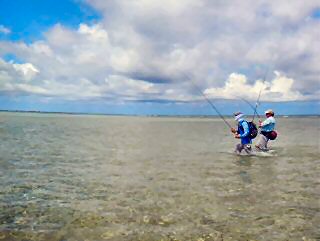 Matthieu handily carries the rods for different fish and he handed Rich his 12-weight with a large poodle fly. The giant trevally (GT) was moving uncharacteristically slow but in our direction. Rich peeled off 70 feet of line, made a practice cast then stripped in and waited. Soon it was time and Rich landed his poodle perfectly about ten feet ahead of the trevally. With the rod tip down Rich began a violent strip. Before the second strip the trevally was on!
Matthieu handily carries the rods for different fish and he handed Rich his 12-weight with a large poodle fly. The giant trevally (GT) was moving uncharacteristically slow but in our direction. Rich peeled off 70 feet of line, made a practice cast then stripped in and waited. Soon it was time and Rich landed his poodle perfectly about ten feet ahead of the trevally. With the rod tip down Rich began a violent strip. Before the second strip the trevally was on!
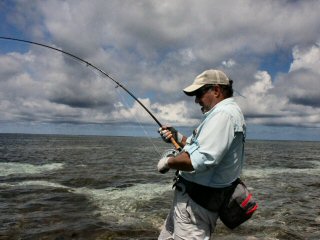 The shear power of a GT surprises all anglers who haven’t yet hooked one. The initial run is astounding and if you’re not careful can end before you enjoy it. The best plan is to tighten your drag to the fullest and start running after the fish. Undoubtedly this backing stealing fish had Rich in awe!
The shear power of a GT surprises all anglers who haven’t yet hooked one. The initial run is astounding and if you’re not careful can end before you enjoy it. The best plan is to tighten your drag to the fullest and start running after the fish. Undoubtedly this backing stealing fish had Rich in awe!
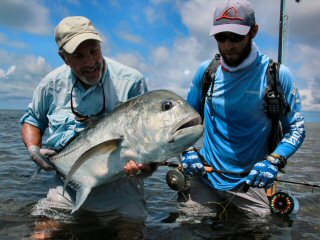 Rich went on to handle his GT beautifully. Both he and Matthieu charged after the oversized jack-like fish aggressively and kept him from the dangerous leader severing corals in every direction. There were definitely some close calls but the end result was an efficient tail grab by Matthieu followed by several celebratory hero shots.
Rich went on to handle his GT beautifully. Both he and Matthieu charged after the oversized jack-like fish aggressively and kept him from the dangerous leader severing corals in every direction. There were definitely some close calls but the end result was an efficient tail grab by Matthieu followed by several celebratory hero shots.
With the tide roaring in wading the flats came to an end before noon. Matthieu took us to a deep turtle grass flat to drop anchor and have a lunch break. We’d be pleasantly interrupted by yet another school of bumpies.
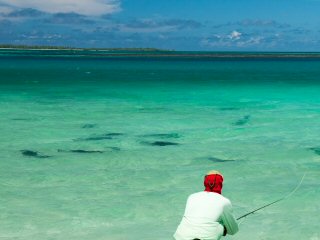 With a GT under his belt, Rich told me to have a go. Here the boats are larger than an ordinary flats skiff and guides don’t use poles to pursue fish. Instead they go overboard and drag the boat along. During the next hour Rich and I got a dozen excellent casts to the bumpies. I had one pick up my fly but on his knuckle busting run the hook pulled. Yes, I was disappointed but the eat was enough to let me know, I can make this happen this week.
With a GT under his belt, Rich told me to have a go. Here the boats are larger than an ordinary flats skiff and guides don’t use poles to pursue fish. Instead they go overboard and drag the boat along. During the next hour Rich and I got a dozen excellent casts to the bumpies. I had one pick up my fly but on his knuckle busting run the hook pulled. Yes, I was disappointed but the eat was enough to let me know, I can make this happen this week.
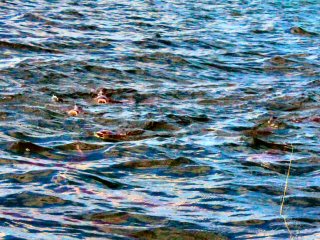 The rest of our day was from the boat. Once again we ran into a massive school of milkfish and Rich made casts to them for an hour. There were so many a catch seemed emanate but no such luck. I kid you not there were thousands of milkfish and at times they were feeding a ten foot cast from the boat. But their diet is 99% plankton and they wouldn’t eat the most proven milkfish fly.
The rest of our day was from the boat. Once again we ran into a massive school of milkfish and Rich made casts to them for an hour. There were so many a catch seemed emanate but no such luck. I kid you not there were thousands of milkfish and at times they were feeding a ten foot cast from the boat. But their diet is 99% plankton and they wouldn’t eat the most proven milkfish fly.
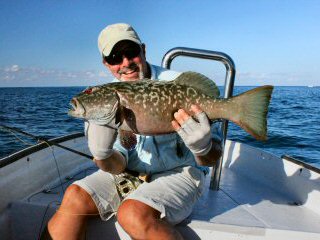 The fishing day ended drifting outside the reef over coral heads. Matthieu attempted to tease GT’s but few fish were around. Rich added a small bohar snapper (two-spot red snapper) and this fine looking brown phase African brown-marbled grouper to his catch. This would be a slow day for me however the spangled emperor was a new species and sightings of numerous bump head parrotfish on the flats would put me to bed with a smile.
The fishing day ended drifting outside the reef over coral heads. Matthieu attempted to tease GT’s but few fish were around. Rich added a small bohar snapper (two-spot red snapper) and this fine looking brown phase African brown-marbled grouper to his catch. This would be a slow day for me however the spangled emperor was a new species and sightings of numerous bump head parrotfish on the flats would put me to bed with a smile.
If Farquhar in the Seychelles sounds like a trip for you feel free to contact me or Yellow Dog Fly Fishing Adventures for more information.

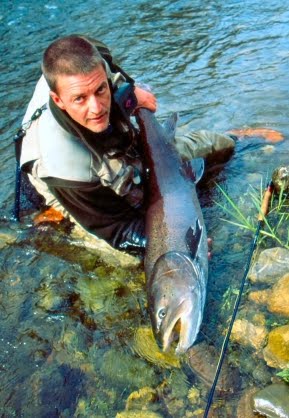
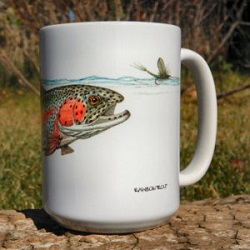











0 Comments